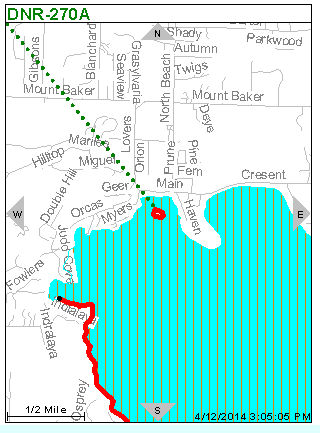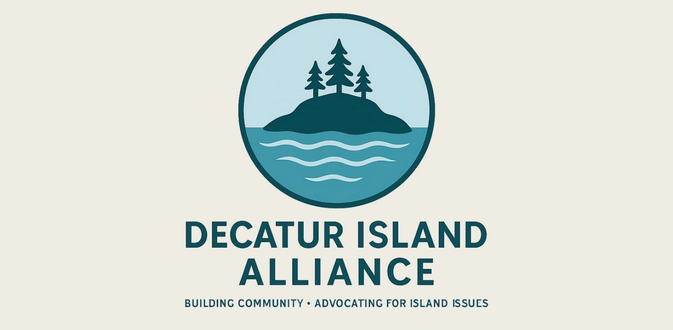— by Lin McNulty —
UPDATE: 3:00 p.m., April 12, 2014
Further investigation reveals that Department of Health considers the waters in East Sound to be closed to recreational and sports shellfish harvest. Commercial operations are closed ONLY if routine testing determines there is a specific problem with the product (shellfish). At this time, the Department of Health has NOT CLOSED commercial shellfish harvesting in East Sound.
 The public beaches listed…are CLOSED to the recreational or sport harvest of the shellfish species listed because of danger from marine biotoxins.
The public beaches listed…are CLOSED to the recreational or sport harvest of the shellfish species listed because of danger from marine biotoxins.
Commercial shellfish harvesting may, or may not, be restricted in those areas, based on selected testing of shellfish lots.
- This text bulletin represents only the Marine Biotoxin health status of public beaches for the recreational or sport harvest of shellfish.
- SOURCES: https://ww4.doh.wa.gov/scripts/esrimap.dll?name=BIOVIEW&Left=1044691&Bottom=1214619&Right=1074691&Top=1255564&click.x=141&click.y=217&Step=3 AND https://www4.doh.wa.gov/gis/mogifs/biotoxin.htm#table
********
A big thank you to our alert, observant readers who, following publication of our story on suspected Red Tide, prompted us to delve deeper into the issue of a “Red Tide” and its toxic effects.
Charleen Bawden, of Judd Cove Oysters, explained that what we are seeing at this time is a non-toxic algal bloom called Noctiluca scintillans, commonly known as the Sea Sparkle. It is not the dreaded Red Tide that causes shellfish to become toxic or deadly to humans.
In fact, a deadly Red Tide is often not even visible!
The term Red Tide is being phased out among researchers for the following reasons:
- Red tides are not necessarily red and many have no discoloration at all.
- They are unrelated to movements of the tides.
- The term is imprecisely used to refer to a wide variety of algal species that are known as bloom-formers.
As a technical term it is being replaced in favor of more precise terminology including the generic term harmful algal bloom for harmful species, and algal bloom for non-harmful species.
According to NOAA, “…not all algal blooms are harmful. Most blooms, in fact, are beneficial because the tiny plants are food for animals in the ocean. In fact, they are the major source of energy that fuels the ocean food web.”
Bawden stresses that they routinely send iced samples of their oysters weekly to the State Department of Health, and receive a reading from the State the very next day. “Only two times in 20 years,” she says, “has Paralytic Shellfish Poisoning (PSP) been found in their oysters.” If a PSP reading of 45 ppm is detected, retesting is required until the level reaches zero and remains there for two weeks. The State will close an area that has a dangerous reading of 80 ppm.
An algal bloom in one area of the island may not show up in another area. Bawden says West Sound and Lopez Island beaches are notorious for the blooms.
If you are growing shellfish on your own beach, or harvesting from an unfamiliar area, the State will provide a sport-fishing test on the product to ensure safety. Their phone number is 800-833-6388.
Bottom line? Those oysters are just as good as ever! And Orcas Issues apologizes for the misunderstanding. Enjoy!
**If you are reading theOrcasonian for free, thank your fellow islanders. If you would like to support theOrcasonian CLICK HERE to set your modestly-priced, voluntary subscription. Otherwise, no worries; we’re happy to share with you.**








There appears to be some differing thoughts on whether or not this was an actual red tide event I observed in Eastsound. My sources for drawing this conclusion were the NOAA website and the Washington State Department of Health website which specifically states that there is a biotoxin beach closure right next to the beach where I observed what I believed to be a red tide. Commercial shellfish operations here in the San Juan Islands are very diligent in testing to assure that their harvesting areas are always safe. I certainly wouldn’t let closures of one beach to stop me from enjoying the oysters harvested on another beach that is routinely tested for safety.
What great research Lin did. In sum, the type of phytoplankton which cause the water to turn red-orange is not poisonous. When the water is a soupy red/orange it may or may not ALSO have what poisons shellfish, but the color does not indicate toxins.
Alejandro is exactly right: the shellfish farmers have to and do check out their product on a regular basis, and NOAA uses people locally to check the water for harmful phytoplankton on a regular basis. I also believe that Kwiáht located next to the post office also does regular testing.
But when there is the orange-red color in the water, go down to the beach at night and play with the water: it sparkles and twinkles beautifully. Each wavelet crests in little stars. It’s nature at its loveliest.
Learned from Dr. Russell Barsch of KWIAHT today, that the foamy stuff (now red because of noctiluca) at the edge of the water is actually–Herring!–the spawn being the largest in several years….good news for those up the food chain.
If anyone wants to learn more about phyto or zoo plankton, they should contact Kwiaht, as samplings are taken from several sites in and around the SJI, and can be seen under the microscope at the little office in the right corner of the Post Office building.
Thank you to all for digging deeper into this phenomenon.
The most important statement in all of the above is Lin’s: “The term ‘red tide’ is being phased out by researchers…”
Bottom line: it’s great to see that we who live surrounded by water are paying attention to what goes on, on and in that water. Isn’t that one reason we choose to live here?